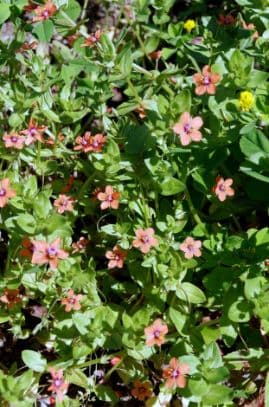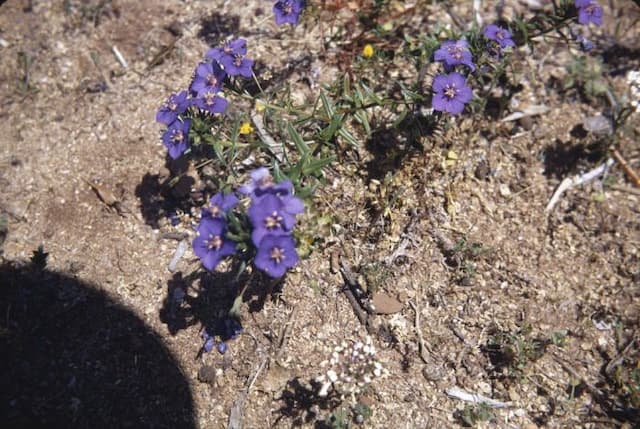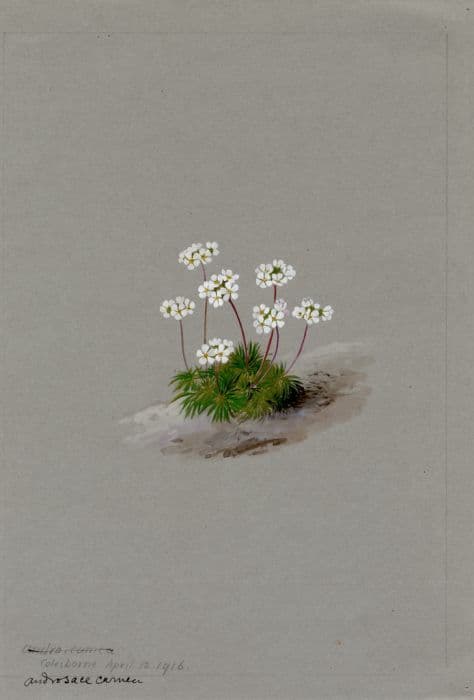Kew Primrose Primula × kewensis (Sp)

ABOUT
Primula × kewensis, also known as Kew Primrose, is a hybrid ornamental plant that boasts a striking appearance. It is characterized by its lush green foliage which forms a rosette-like base for the delicate flowers. The leaves are typically oval to oblong in shape, with a slightly wrinkled texture and may have scalloped or toothed edges, giving them a crinkled appearance. The flowers of the Kew Primrose emerge on stalks that rise above the foliage. These blooms can range from white to shades of yellow, often with a soft gradation of color that adds to their subtle charm. Each flower comprises several rounded petals arranged in a circular pattern, radiating from the center where a small cluster of stamens can usually be seen. Kew Primrose flowers have a distinctive structure with a tubular throat opening up to a flat-faced, star-shaped corolla. The contrast between the vivid green leaves and the softer hues of the flowers creates an inviting display that can add a touch of elegance to a garden setting. The overall aspect of the Kew Primrose is one of delicate beauty, with its modest yet colorful blossoms creating a lovely spectacle when in bloom.
About this plant
 Names
NamesFamily
Primulaceae
Synonyms
Kew Primrose, Kew Hybrid Primrose
Common names
Primula × kewensis
 Toxicity
ToxicityTo humans
Primula × kewensis, commonly known as Kew Primrose, is not typically known for being a toxic plant to humans. There is limited information on its toxicity since it's a hybrid primarily grown for ornamental purposes. However, as with many plants, sensitive individuals may experience mild irritation or an allergic reaction when handling the plant, due to the presence of compounds like primin found in some Primula species. In general, it's advisable to avoid ingesting parts of ornamental plants due to the potential for stomach upset or other adverse reactions.
To pets
Kew Primrose, or Primula × kewensis, does not have a widespread reputation for being toxic to pets. However, similar to its effects on humans, consuming parts of the plant may potentially lead to mild gastrointestinal upset in sensitive pets, as it can with many plants that are not part of their typical diet. While there's no strong evidence to suggest severe toxicity in pets, it is still generally recommended to keep houseplants out of reach to avoid any potential issues.
 Characteristics
CharacteristicsLife cycle
Perennials
Foliage type
Evergreen
Color of leaves
Green
Flower color
Yellow
Height
6-12 inches (15-30 cm)
Spread
6-12 inches (15-30 cm)
Plant type
Herb
Hardiness zones
5
Native area
Hybrid
Benefits
 General Benefits
General Benefits- Aesthetic Appeal: Adds vibrant colors and textural interest to gardens with its attractive blooms.
- Seasonal Interest: Flowers in late winter or early spring, providing early color when few other plants are in bloom.
- Pollinator Attraction: Attracts bees and butterflies, supporting local ecosystems.
- Varied Cultivars: Comes in a range of colors and forms, allowing for garden customization.
- Low Maintenance: Generally requires minimal care once established in the right conditions.
- Compact Growth: Suitable for rock gardens, alpine beds, or small spaces due to its compact size.
- Cold Tolerant: Resistant to cold temperatures and can thrive in cooler climates.
- Long Blooming: Often has a lengthy blooming period that extends the visual enjoyment.
 Medical Properties
Medical PropertiesThis plant is not used for medical purposes.
 Air-purifying Qualities
Air-purifying QualitiesThis plant is not specifically known for air purifying qualities.
 Other Uses
Other Uses- Floral Art: Primula × kewensis, commonly known as Kew Primrose, can be used in floral arrangements for its beautiful blooms, adding a pop of color and delicate texture.
- Educational Tool: This hybrid plant can serve as a learning tool in botany classes to demonstrate hybridization and plant genetics due to its origin from crossing species within the Primulaceae family.
- Culinary Decoration: Although not widely used for eating, the flowers of Kew Primrose can garnish desserts and salads for an attractive presentation due to their striking colors.
- Photography Subject: Kew Primrose, with its unique beauty, is often used by photographers as a subject for botanical photography and plant portraiture.
- Butterfly Gardening: The plant can be part of a butterfly garden as its flowers may attract pollinators, offering a nectar source for them.
- Pressing and Crafts: The flowers of Kew Primrose can be pressed and used in crafts such as handmade paper or botanical prints.
- Color Dye: Historically, certain primula species were used as natural dyes, and this hybrid may also hold potential for creating dyes for fabrics or art projects.
- Seasonal Festivities: In some cultures, Primula flowers are associated with spring and are used in decorations for festivals or celebrations that welcome the season.
- Wax Modeling: The striking form and color of Kew Primrose's flowers make them good candidates for creating detailed wax models for educational or ornamental purposes.
- Feng Shui: Some practitioners of Feng Shui might use the Kew Primrose as an element in gardens or spaces to balance energy and promote a tranquil atmosphere.
Interesting Facts
 Feng Shui
Feng ShuiThe Kew Primrose is not used in Feng Shui practice.
 Zodiac Sign Compitability
Zodiac Sign CompitabilityThe Kew Primrose is not used in astrology practice.
 Plant Symbolism
Plant Symbolism- Youthfulness: Kew Primrose, as a symbol of spring and new growth, often represents the concept of youth or renewal.
- Hope: Like many flowers that bloom early in the year, the Kew Primrose can symbolize hope and the anticipation of better things to come.
- Delicacy: The fragile and delicate flowers of the Kew Primrose may suggest tenderness and the need for gentle care in relationships or endeavors.
- Positivity: Its bright and cheerful colors are thought to herald positivity and joyfulness, making it an emblem of good spirits.
 Water
WaterKew Primrose should be watered thoroughly once the top inch of soil feels dry to the touch, which typically means watering approximately once a week. The frequency may vary depending on the humidity and temperature of the environment. It's essential to avoid overwatering and ensure proper drainage to prevent root rot. Generally, you may need to use about 16-24 ounces of water for a medium-sized pot, adjusting the amount based on the size of the plant and pot. During active growth in the spring and summer, keep the soil consistently moist but not soggy.
 Light
LightKew Primrose thrives in bright, indirect light but can also tolerate partial shade. It's best to avoid direct afternoon sunlight, which can scorch the leaves. A north or east-facing window is ideal for providing the gentle light that this plant prefers. If you're growing Kew Primrose outside, place it in a spot that receives dappled sunlight or has light shade from larger plants.
 Temperature
TemperatureKew Primrose prefers cool to moderate temperatures, thriving best between 50 to 65 degrees Fahrenheit. It can survive temporarily outside this range but should not be exposed to temperatures below freezing or above 80 degrees Fahrenheit. The cool temperatures of spring and fall are typically ideal for this plant, and it may benefit from cooler temperatures at night.
 Pruning
PruningPruning Kew Primrose is primarily done to remove dead or faded flowers, which encourages further blooming and maintains the plant's appearance. It's best to deadhead the flowers after they have bloomed, which can occur multiple times during the spring. Lightly trimming the plant can also help to shape it and promote denser growth. Pruning is not frequently required but can be done after the main blooming period.
 Cleaning
CleaningAs needed
 Soil
SoilKew Primrose prefers well-draining soil rich in organic matter with a slightly acid to neutral pH of 6.0 to 7.0. A good mix can be made with equal parts peat, loam, and perlite to ensure adequate drainage and fertility.
 Repotting
RepottingKew Primrose should be repotted every 1-2 years to replenish nutrients and prevent root crowding. It's best done in late winter or early spring before the onset of vigorous growth.
 Humidity & Misting
Humidity & MistingKew Primrose thrives in moderate to high humidity levels, around 50-70%. It benefits from a humid environment, which can be provided by a pebble tray with water or regular misting.
 Suitable locations
Suitable locationsIndoor
Kew Primrose needs bright, indirect light and regular watering indoor.
Outdoor
Plant Kew Primrose in partial shade, moist, well-draining soil outdoor.
Hardiness zone
5-9 USDA
 Life cycle
Life cyclePrimula × kewensis, commonly known as Kew Primrose, begins its life cycle as a seed, which upon finding suitable moist and cool conditions, germinates into a young seedling. The seedling grows into a vegetative rosette of leaves at the soil surface, developing a root system that anchors it into the ground and absorbs nutrients. As the plant matures, it produces flowering stalks adorned with clusters of typically yellow flowers, which are the result of a controlled hybridization process. After pollination, which may be facilitated by insects, the flowers develop into capsules containing numerous tiny seeds. These seeds are then dispersed by various means, such as wind or water, to begin the cycle anew. The plant may also spread asexually through division, where parts of the root structure are separated to grow into new individual plants, thus perpetuating the species.
 Propogation
PropogationPropogation time
Spring-Early Summer
Primula × kewensis, commonly known as Kew Primrose, is typically propagated through division, which is a popular method for many perennial plants. The best time to propagate through division is in late winter or early spring before new growth begins. To do so, the root clump of the mature plant is gently taken out of the ground and carefully divided into smaller sections, ensuring that each new section has a portion of the root and several shoots. These sections are then replanted in prepared soil, spaced appropriately to account for their future growth. It is important to water the newly planted sections well and keep them moist until they are established. This method of vegetative propagation helps maintain the true characteristics of the parent plant and allows gardeners to quickly increase their stock.









